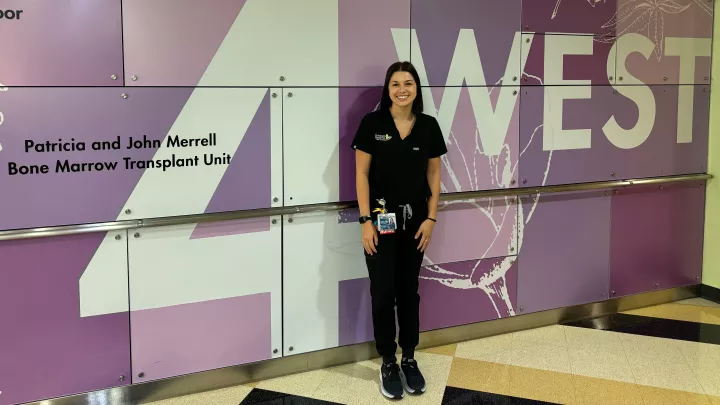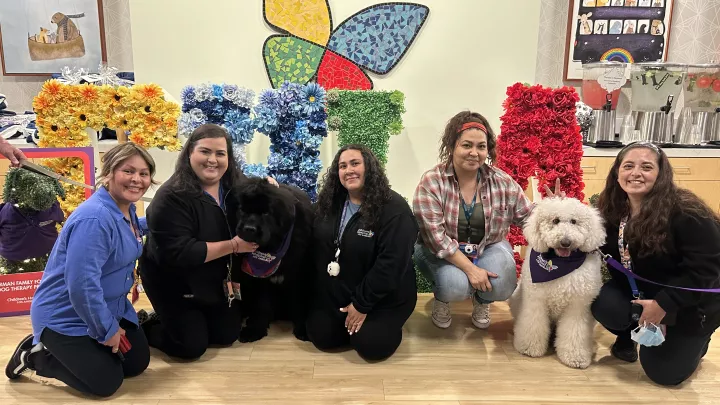
More Furry Friends Needed! Dog Therapy Program in High Demand at Hospital
The Amerman Family Foundation Dog Therapy Program is growing! They’re especially seeking volunteers who are available on weekdays. Whether your dog is a seasoned therapy animal, or you think your dog would be a great fit, learn more about volunteering here.
As Kacey Buhrmaster walks through the staff doors of the Children’s Hospital Los Angeles Sunset campus, security badge in tow, she knows it’s going to be a good day.
It’s only a matter of steps before someone stops her to say hello. If that person was feeling anxious, sad, or frightened before, Kacey is confident those feelings have faded, at least while she visits with them. It’s kind of her superpower—and the reason CHLA hired her in the first place.
She flops onto her back, showing off her belly to her new friend, and earns a giggle. Not all CHLA team members have clearance to lie on the floor, but the hospital makes special exceptions for those like Kacey. It’s actually a critical tactic of hers.
Kacey’s partner, Kate, tells her new friend they’re headed for the Heart Institute today. Kacey gives her friend one last nuzzle, and they’re off.
Time to get to work.
Dogs with jobs
If you haven’t yet guessed, Kacey is one of CHLA’s Therapy Dogs—a 9-year-old Bernese Mountain Dog with an always outstretched tongue that might belong in a book of world records. Her “partner,” Kate Buhrmaster, leads the Amerman Family Foundation Dog Therapy Program.
“We hope every therapy dog loves their job,” says Buhrmaster. “For dogs that love people, being able to reach so many is something they thrive on.”
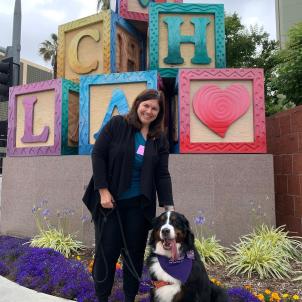
The program started at CHLA in 2001 with just a couple of volunteers and their dogs and has expanded over multiple iterations. “What began with three or four dogs based on one unit is now a roster of 100-plus therapy dogs that cover all different destinations around the hospital,” says Buhrmaster. “We're in every inpatient unit except for Bone Marrow Transplant. We're in a dozen outpatient clinics, treatment areas, and waiting rooms.”
Buhrmaster never imagined a career in Dog Therapy, but in 2008, her late dog, Elsie, inspired her to volunteer. “I had one of those dogs who felt she was an ambassador for dog kind,” she recalls. “She would just stop on the sidewalk and make eye contact with people. She could connect with them so easily.”
At Buhrmaster and Elsie’s first day volunteering at CHLA, she recalls helping a child who was nervous about walking on their new prosthetic leg. With Elsie’s motivation, the child stood and walked the length of the hallway with their walker. “That’s when it clicked for me,” Buhrmaster says. “That experience made such an impression that I wanted to figure out how we could go deeper.”
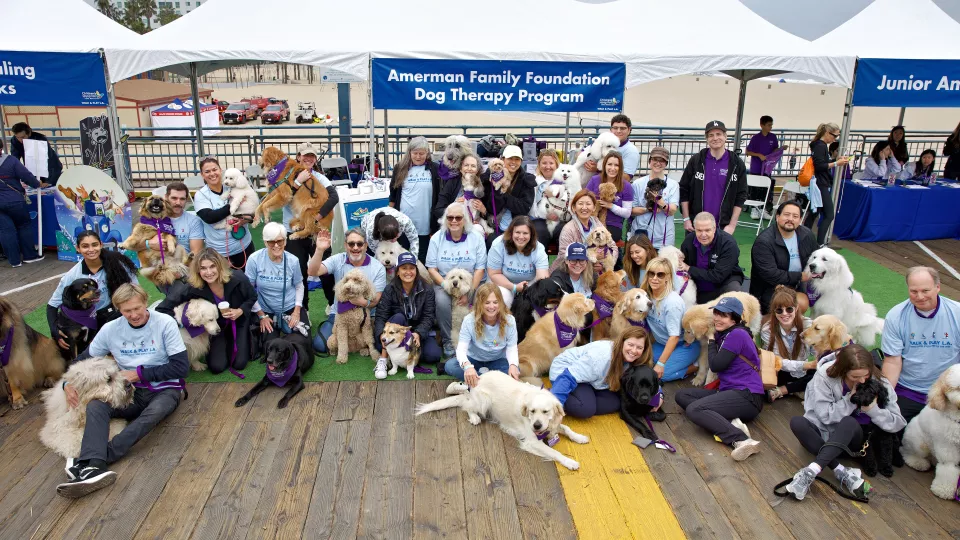
Two decades of program growth
In 2013, Buhrmaster joined the Dog Therapy Program as a full-time team member. She reflects on how the program has grown in that time—not just in size but also in terms of what it can offer patients. “We work in many more specialized ways today. There’s a lot of creative problem solving,” Buhrmaster says. “Each day, we ask ourselves, ‘What does this particular patient need, and what do they respond to?’ That has been a big part of the magic for me.”
Before Kacey, Buhrmaster worked with two other therapy dogs (and mentions that Kacey has two little sisters at home training to do the same). “They’ve each approached the job in a slightly different way, but they’ve all been able to partner with me to figure out the best-practice approaches that we then teach to our volunteers,” she reflects.
Health benefits of dog therapy
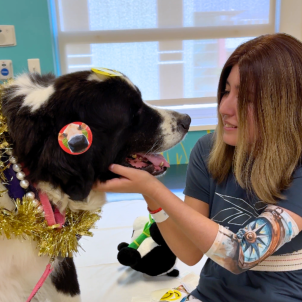
The field of animal-assisted interventions has expanded greatly over the past 25 years, from disease detection to military. Dog therapy specifically is shown to lower heart and respiratory rates and even help the brain produce “feel-good hormones” like oxytocin. “Our bodies tend to calm and regulate when we’re touching a dog,” Buhrmaster says.
She explains that building positive associations with potentially challenging or scary activities is another key benefit to kids visiting the hospital. “Dogs are something pleasant, nonjudgmental, and separate from their hospital experience.”
Making those positive connections and associations while in the hospital can mean a patient reports less anxiety, depression, loneliness, and isolation overall.
“There’s something wonderful about having something to look forward to and focus on even when you're in a tough situation,” Buhrmaster says. “We've had kids who make albums of the dogs’ trading cards. We've had kids who keep track of which furry friends they've met and which they haven't.”

Volunteers needed!
The program continues to grow and is seeking new volunteers to help meet demand across CHLA’s Sunset campus and outpatient centers. Below, Buhrmaster and Program Coordinator Anne Marie Scibelli help answer key questions for interested dog owners.
Why volunteer?
“If you’re a regular person within your regular life and you are not of a medical background, this is the most incredible opportunity to impact the health and recovery of other people,” says Buhrmaster. “You will play an active role in inspiring a kid to get out of bed and walk, or to start talking to their parents when they've been quiet and shut down, or to just giggle and enjoy childhood for a moment in a tough situation.”
“What we’re really looking at is a dedicated volunteer, and that's what we are trying to cultivate," adds Scibelli, “Someone who's committed for the long-term,” adds Scibelli.
What kinds of dogs are you looking for?

“I ran into a nurse this morning who said, ‘The therapy dogs here are the goodest dogs.’ That’s so true,” says Buhrmaster. “If you have a ‘goodest dog’ and wonder how they can brighten lives beyond your immediate circle, dog therapy could be a wonderful experience.”
“We have volunteers of all ages and breeds. A lot of what we're cultivating is just dogs that enjoy connecting with people,” adds Buhrmaster. “That is at the heart of this job, that if they love to be greeted by people, say hello to people, and spend time with people, they could really thrive in this environment.”
“We’re ready to talk to you wherever you and your dog are on the spectrum of readiness,” says Scibelli.
What does the commitment look like?
“There’s an education and testing component, as well as on-the-job training,” shares Scibelli. “It’s something we ask volunteers to commit to regularly, but we also offer a lot of flexibility. The Dog Therapy Program runs seven days a week, from 9 a.m. until 9 p.m.—so there is a way to fit volunteering into a lot of different schedules.
“Right now, we could particularly use dog teams that have more availability in peak daytime hours,” Scibelli notes. “We want to be able to respond to the increase in requests in a timely fashion.”
A unique opportunity

What do Buhrmaster and Scibelli want potential volunteers and their pups to understand about dog therapy at CHLA?
“If helping kids is appealing to you, this is a really unique opportunity,” says Buhrmaster. “Dogs aren't just a novelty here. They're partners in the much bigger goal of making this a wonderful environment for recovery.”
Partners? Kacey would agree.
